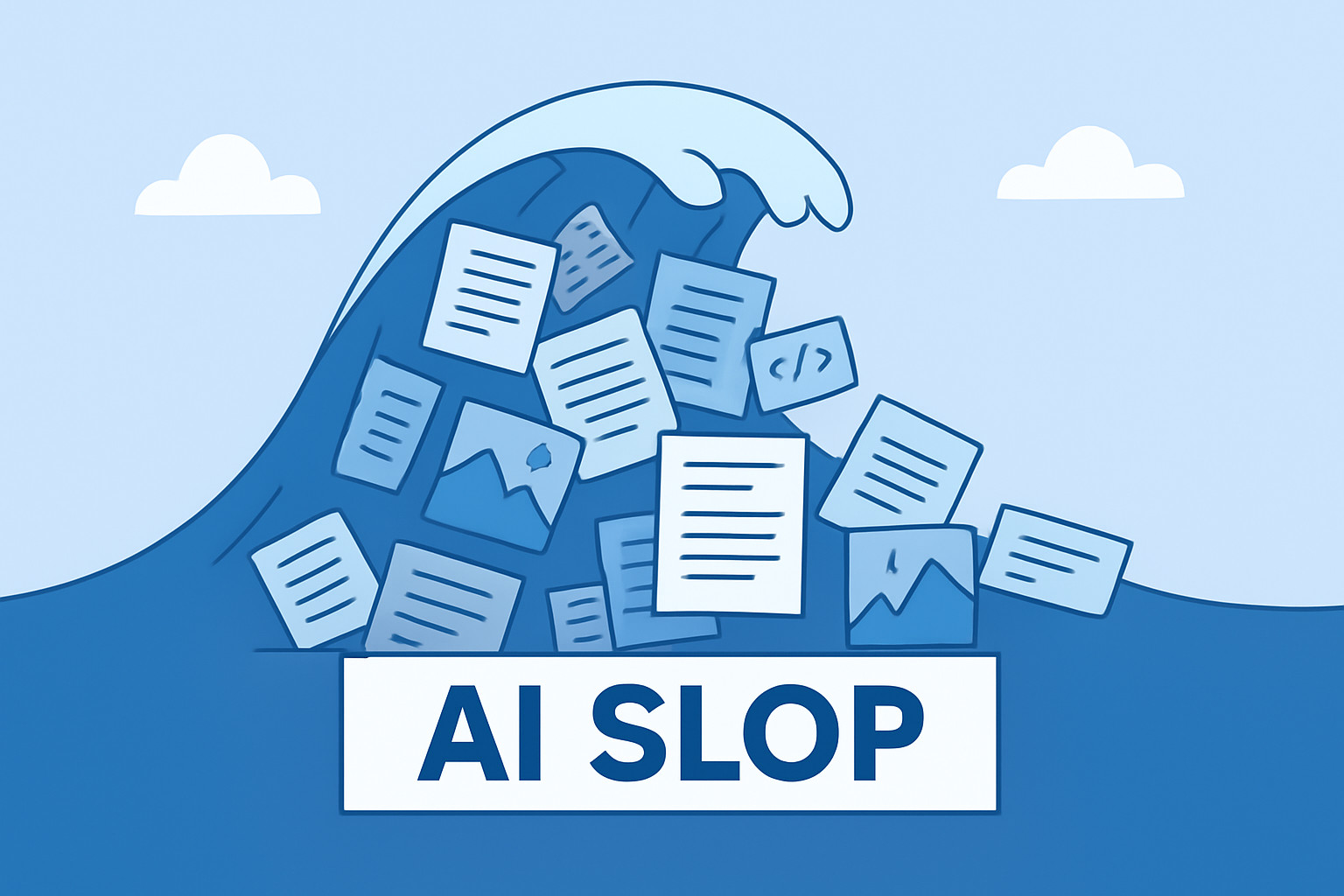AI Slop: Are We Ready for It?
|
|
One of the biggest technological advancements of the last decade has been the meteoric rise of generative AI. We have surpassed the stages of being amazed by AI’s capability to complete simple sentences to watch it with trepidation as it creates photorealistic images, writes code, produces marketing copy, and even replicates human speech, all in a matter of a few short years. But like every coin has two sides, this technological change came with its own range of drawbacks. One of the main new issues is what many call “AI Slop”.
The phrase “AI Slop” refers to the low-quality, mass-produced, algorithmically generated content that is prevalent online. This covers code, images, videos, and text that appear polished on the surface. However, it lacks originality, value, substance, and accuracy. It is content produced in haste, in large quantities, and often with nearly zero human intervention. And this sludge saturates the internet, people and organizations must ask themselves:
Are we really ready for the consequences of AI Slop?
| Key Takeaways: |
|---|
|
This blog will go into what AI Slop is, why it is so popular, the risks it poses, and how organizations can stay safe. Additionally, we will also see how AI-powered tools help teams to protect against the negative impact of AI-generated low-quality output.
What Is AI Slop? Understanding the Rise of Low-Quality AI Content

AI Slop is much more than just “bad content.” It is a systemic byproduct of generative AI ecosystems, where users find it difficult to differentiate between AI-generated noise and real work. Platforms obviously reward engagement over quality, and AI content is quick and inexpensive to generate.
AI slop includes a range of outputs:
Low-Quality AI-Generated Text
Articles, blogs, product descriptions, emails, and scripts are generated in a matter of seconds. These often contain repeated phrases, generic language, errors, or hallucinations. They might appear to be clear and readable, but they lack depth and are not supported by facts.
Synthetic Images and Videos
Anyone can now generate stylized or photorealistic images with AI art generators. But a lot of the output is repetitive or incoherent. Think in the lines of uncanny-valley faces, odd artifacts, surreal proportions, extra fingers, and mismatched lighting.
Sloppy AI-Generated Code
- Inability to understand business logic.
- Ignore edge cases.
- Create brittle tests.
- Introduce security flaws.
- Produce code that “works” now but breaks later.
This is what is called “vibe coding”, AI-generated code that is based on probabilistic patterns rather than true understanding.
AI-Generated Audio & Voice Clones
While inexpensive tools continue to generate robotic pacing, unnatural inflection, and wrong emphasis, synthetic voices are swiftly improving. These increase the risk of deepfakes and contribute to a general deterioration in media quality.
Algorithm-Driven Social Media Noise
- Buzzword-heavy posts
- Very typical inspirational quotes
- Low-effort viral bait
- Fake engagement
The result is a digital environment drowned in filler.
Why AI Slop Is Exploding: The Perfect Ecosystem for Low-Quality Content
The Barrier to Creation Has Never Been Lower
Ten years ago, it took skill, time, and effort to write a good blog, illustration, or short film. A smartphone user can now generate results that are almost professional in a matter of minutes.
It is great that creating has become democratized; anyone can do it. But here quantity overwhelms quality.
Algorithms Reward the Wrong Things
- Clicks
- Shares
- Completion rate
- Watch time
Algorithms only reward engagement; they are unable to differentiate between value and nonsense.
This is the right environment for the growth of AI Slop.
Financial Incentives Promote Speed Over Craft
- Entire websites
- SEO blogs
- Low-effort news aggregations
- Fake reviews
- AI-written product listings
The result? A polluted digital ecosystem.
The Hidden Costs and Risks of AI Slop
More than being just an inconvenience, AI Slop is becoming a bigger problem for many industries.
Information Pollution and Erosion of Trust: Trust in digital content reduces when the general public is unable to identify what is real, meaningful, or authoritative.
- Journalism
- Product recommendations
- Science communication
- Technical documentation
- Educational materials
These days, “vibey but false” explanations that seem intelligent but lack substance are choking platforms.
Creativity Devaluation: Today, an ocean of free, AI-generated knockoffs competes with original creators. It is now possible to duplicate images, illustrations, articles, and songs in a matter of seconds.
Some authors and artists define this era as “a battle for the soul of creativity.”
- False accusations
- Deepfake scandals
- Fake reviews
- Misattributed quotes
- Identity misuse
For brands, the stakes are astronomical.
Lower Quality Software and AI-Generated Code Issues: One of the most under-discussed categories of AI Slop is bad code.
- Incorrect logic
- Security vulnerabilities
- Non-compliant solutions
- Test scripts that break easily
Code that “looks right” but fails in production
As they have blindly trusted AI-generated code, many organizations are seeing an increase in technical debt.
Compounding Feedback Loops: The fact that AI models learn from the output of previous AI models is one of the biggest long-term risks.
New models are trained on AI Slop, which in turn generates more slop as the web fills with it. This creates a self-reinforcing degradation cycle.
AI Slop in Software Development: Why It’s a Growing Concern for Engineering Teams
- Unit tests
- API wrappers
- Snippets of code
- UI elements
- Full functions
- End-to-end tests
While the unchecked output can be problematic, it is not inherently bad.
The Risks of AI-Generated Code Slop
Context missing- AI makes educated guesses based on patterns rather than understanding business rules or requirements.
- Shallow testing: Generated tests often overlook edge cases while verifying “happy paths.”
- False confidence: Fluent-looking code makes developers assume it functions properly.
- Increased Fragility in Automation: When AI builds UI automation scripts, they often:
- Break when the UI changes.
- Use unstable selectors.
- Don’t match real user workflows.
- Produce inconsistent results.
- This leads to flaky tests that erode QA trust..
- Security Blind Spots: AI is not able to inherently reason about:
- Secure defaults
- Encryption best-practices
- Compliance requirements
- OWASP standards
Silent vulnerabilities are a direct result of this.
The Feedback Loop Problem: How AI Slop Reinforces Itself
The feedback loop problem is a cyclical process where AI-generated content becomes training data for future AI models. It causes a slow degradation in quality over time. This is one of the most pressing but least discussed issues related to AI Slop. This phenomenon is also called model collapse and data poisoning-by-abundance. It has serious consequences for the long-term dependability of AI systems.
How the Feedback Loop Forms
- High-quality articles
- Human-created artwork
- Expert code
- Verified reference materials
- Educational and academic resources
However, the ratio of human-generated versus AI-generated content is rapidly reducing as the internet becomes more and more crowded with AI-generated output.
- AI-written blogs
- AI-altered images
- AI-compiled code
- AI-generated misinformation
- Synthetic noise mixed with genuine data
As a result, AI Slop is included in training data for the next generation, leading to a pipeline of
sloppy data → sloppy models → more sloppy data
Why This Is a Serious Problem
- Degradation of AI Accuracy: Models begin to lose their capability to differentiate between pattern-based hallucinations and facts.
- Amplification of Errors: Mistakes generated by one model are re-learned and amplified by others.
- Loss of Diversity in Outputs: Recycled AI data leads to “the collapse of originality,” or homogenized, derivative, repetitive content.
- Increased Bias and Drift: Bias increases unintentionally if AI trains on flawed synthetic content, and outputs deviate further from the objective truth.
- Reliability Risks for Businesses: Organizations that rely on AI-generated code, documentation, or insights run the risk of unintentionally including the mistakes of several model generations.
Preventing the Feedback Loop
- Training pipelines must continue to depend heavily on human-curated datasets.
- Machine-generated content should be eliminated from training corpora by AI detection systems.
- Provenance tracking is necessary, or metadata defining the creation process of content, to be standardized across platforms.
- Standards and regulations may eventually demand that businesses label content generated by artificial intelligence.
- Workflows that merge AI and humans should continue to be the rule rather than the exception. The basic principle is simple. AI should be trained on humankind’s biggest achievements rather than its byproducts.
As AI continues to squeeze its way into every facet of digital creation, it is important to understand and solve the feedback issue. This is needed to maintain the integrity of AI itself as well as the quality of the content.
How Organizations Can Stay Ahead of AI Slop
- Transparency and Human Oversight: AI should improve, not replace human creativity. Human review must continue to be a top priority for organizations.
- Strong Testing Pipelines: Your testing needs to be more reliable, automated, and scalable as AI tools produce more code.
- Quality-First Culture: Uniqueness, accuracy, and worth need to be rewarded more than speed.
- Use AI Wisely: It is good to remember that while AI is a good tool, it cannot replace human judgment or experience.
- Adopt Anti-Slop QA Tools: In a world boosted by AI, a trustworthy testing layer is important. Teams can release faster without sacrificing quality.
Are We Ready for AI Slop? Not Quite — But We Can Prepare
In actuality, a change is just getting kicked off. Platforms, companies, and regulations are failing to match the strides of rapidly escalating AI Slop.
Being prepared, however, does not imply doing away with AI; rather, it means putting in place the right mechanisms to examine, filter, and verify its results.
- Better governance
- Better quality checks
- Better validation tools
- Better testing practices
And that’s exactly where testRigor and other test automation tools are useful.
How testRigor Helps Organizations Fight AI Slop in Software Development
Software slop isn’t just content. It is also faulty code, shaky automation, and unreliable testing that are all consequences of faster AI-assisted development.
testRigor offers multiple successful solutions to resolve this issue.
Validates AI-Generated Code Before It Goes Live
Engineering teams need end-to-end functional tests to validate that the system behaves as expected, rather than depending only on code review.
enter "[email protected]" into "Email" enter "MyPassword123" into "Password" click "Log in" check that page contains "Welcome back, John"
- AI-generated UI or backend code meets actual requirements.
- Business logic is verified independently of implementation.
- Teams don’t have to blindly trust AI-generated snippets
Eliminates Fragile AI-Generated Automation Scripts
- Brittle locator-based tests.
- Scripts tied to CSS/XPath selectors.
- Tests that break when the UI shifts.
- It avoids relying on fragile selectors.
- It communicates with the app as a user would.
- It identifies elements both semantically and visually.
Thus, it makes the ideal anti-slop testing tool. Read about testRigor Locators.
Makes QA Scalable Even as AI Accelerates Development
QA teams need to match the stride when AI accelerates the writing of code.
- Automating end-to-end tests.
- Decreasing maintenance.
- Allowing non-technical team members to write automated tests in plain English.
- Supporting rapid release cycles.
More AI Slop in production is due to faster development cycles without strong testing. testRigor’s testing leads to a better balance.
Can Test AI-Driven Interfaces
- AI recommendations
- Chatbots
- AI-generated UI
- Adaptive responses
The tool can verify AI-dependent flows utilizing natural-language tests.
This ensures that AI features work as expected, even when generative models are off the underlying logic.
Helps Establish Strong AI Governance
- Every feature works as intended.
- Every update is validated.
- No functionality breaks unexpectedly.
- Code, whether human-written or AI-generated, is thoroughly validated.
An important component of this governance framework is testRigor.
AI Slop Is Here, But We’re Not Helpless
- For people, this includes developing into more intelligent consumers.
- For creators, it includes adapting to uniqueness and artistic integrity.
- For businesses, especially software companies, it means securing systems that examine and verify AI output.
And this is where testRigor and other tools lend a helping hand. The tool helps companies by providing dependable, intelligent, and readable test automation.











